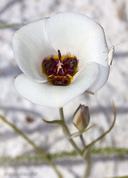Taxon Report
Calochortus excavatus GreeneInyo County star-tulip |
 © 2017 Aaron Schusteff |
Taxon Summary
Calochortus excavatus, commonly known as Inyo County star-tulip, is a perennial bulbiferous herb in the Liliaceae that is found only in California. It occurs within Chenopod scrub, and Meadows and seeps, growing at elevations from 1150 to 2000 meters. Calochortus excavatus is ranked 1B.1, Plants Rare, Threatened or Endangered in California and Elsewhere; Seriously threatened in California.Classification
|
Scientific Name: |
Calochortus excavatus Greene |
|
Common Name: |
Inyo County star-tulip |
| Family: | Liliaceae |
| Element Code: | PMLIL0D0F0 |
| USDA Plants Symbol: | CAEX2 |
|
Synonyms/Other Names: |
|
Ecology and Life History
| Lifeform: | perennial bulbiferous herb |
| Blooming Period: Apr-Jul | Apr-Jul |
| Elevation: | 1150-2000 (3775-6560) |
| General Habitats: | Chenopod scrub, Meadows and seeps |
| Microhabitat: | Alkaline, Mesic |
| Microhabitat Details: |
Conservation Status
| CA Rare Plant Rank: | 1B.1 |
| Global Rank: | G2 |
|
State Rank: |
S2 |
| State List: | None |
| Fed List: | None |
| Other Status: | BLM_S; SB_SBBG; USFS_S |
|
CRPR Changes: |
|
Occurrence Data from the CNDDB
| Total Occurrences: | 70 |
| Element Occurrence Ranks: | |
| Excellent (A) | 1 |
| Good (B) | 21 |
| Fair (C) | 25 |
| Poor (D) | 5 |
| None (X) | 0 |
| Unknown (U) | 18 |
| California Endemic: True | |
| California Counties and Islands: Name (Code) | |
| Inyo (INY), Mono (MNO) | |
| Quads: Name (Quad Code) | |
| Benton Hot Springs (3711875), Big Alkali (3811922), Big Pine (3711823), Bishop (3711834), Blackrock (3611882), Chalfant Valley (3711853), Chidago Canyon (3711854), Convict Lake (3711857), Deep Springs Lake (3711831), Fish Slough (3711844), Fish Springs (3711813), Independence (3611872), Kearsarge Peak (3611873), Laws (3711843), Lone Pine (3611851), Manzanar (3611862), Poleta Canyon (3711833), Rovana (3711845), Tinemaha Reservoir (3711812), Toms Place (3711856), Union Wash (3611861), Westgard Pass (3711832) | |
Threat List Data from the CNDDB
| Threat List Total: | 9 | |
| EOs with Threat Listed: | Total EOs | % of EOs |
| 45 | 64 % | |
| Grazing | 40 | 57% |
| Recreational use (non-ORV) | 4 | 5% |
| Road/trail construction/maint. | 3 | 4% |
| Other | 3 | 4% |
| Groundwater pumping | 3 | 4% |
| Non-native plant impacts | 2 | 2% |
| Vandalism/dumping/litter | 2 | 2% |
| ORV activity | 1 | 1% |
| Improper burning regime | 1 | 1% |
Notes
| Most occurrences are small remnants of former populations. |
|
Threats: |
| Threatened by groundwater pumping, development, non-native plants, road maintenance, and grazing. |
|
Taxonomy: |
| See Pittonia 2:71 (1890) for original description, and Proceedings of the California Academy of Sciences III 2:146 (1901) for taxonomic treatment. |
Selected References
| Proposed Change from CRPR 1B.1, G2G3 to 1B.2, G2 / S2 (2011) |
Citation
California Native Plant Society, Rare Plant Program. 2025. Rare Plant Inventory (online edition, v9.5.1). Website https://www.rareplants.cnps.org [accessed 23 December 2025].